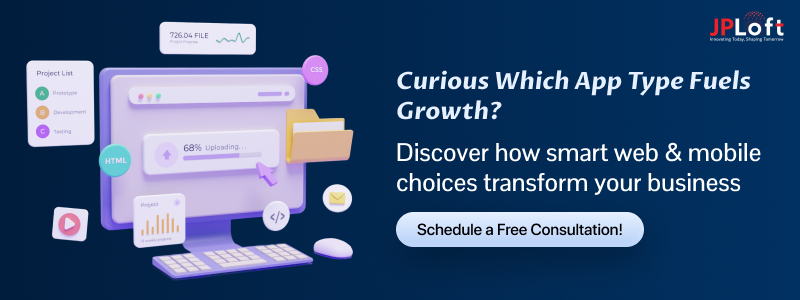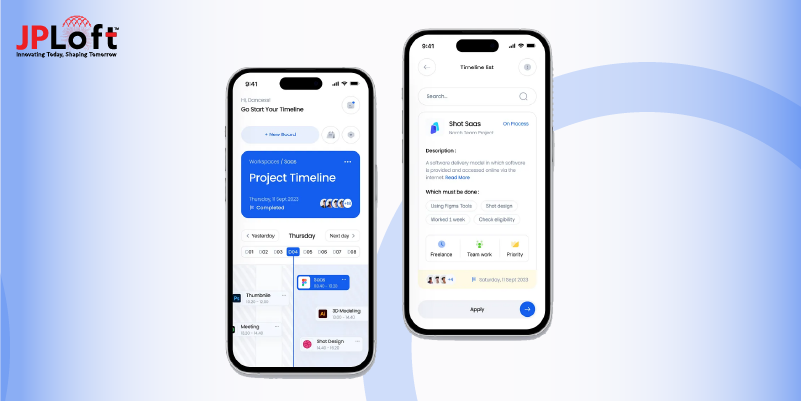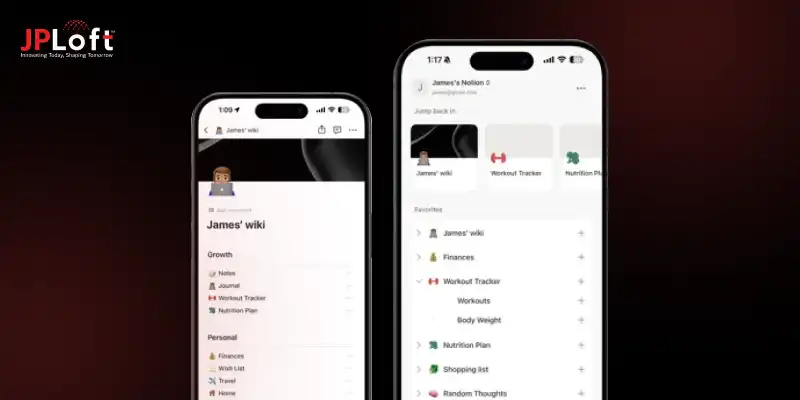Key Takeaways
Choosing between a web app and a mobile app depends on your audience, business goals, and desired user engagement.
Web apps offer accessibility across devices and faster market entry, while mobile apps provide performance, offline access, and richer native features.
Budget, timelines, and scalability should guide the platform decision, balancing initial investment with long-term ROI.
Integrating AI, ML, and analytics can enhance app functionality, personalization, and overall user experience regardless of platform.
Security, compliance, and post-launch maintenance are crucial for sustained success and user trust.
Evaluating team skills, technology stack, and development strategy ensures your app is future-ready and scalable.
Partnering with an experienced development company like JPLoft helps turn your app idea into a high-quality, market-ready product with strategic guidance.
In today’s fast-paced digital world, businesses face a critical choice: should they invest in a web app or a mobile app? Both options offer unique opportunities to engage customers, streamline operations, and boost revenue, but choosing the wrong path can lead to wasted resources and missed growth.
Web apps and mobile apps serve similar purposes but differ in accessibility, functionality, and user experience. While web apps are accessed through browsers and work across devices, mobile apps are installed directly on smartphones or tablets, often providing richer native experiences.
Understanding the difference between mobile apps vs web apps is essential for startups, entrepreneurs, and investors aiming to make informed, strategic decisions.
This guide explores the Web App Vs Mobile App debate, offering insights on pros and cons, investor perspectives, and a step-by-step framework to help you choose the right path for your business.
By the end, you’ll have a clear roadmap to determine what aligns best with your goals, budget, and audience, a mobile app or a web app?
What is a Web App Vs Mobile App?
Understanding the difference between web apps and mobile apps is crucial before making any development decisions. While both aim to deliver value to users, their design, accessibility, and functionality vary significantly.
What is a Web App?
A web app is an application that runs in a web browser, meaning users can access it via any device with an internet connection, such as a desktop, laptop, or mobile device, without needing to download anything. Because it’s browser-based, updates roll out instantly and there’s no app-store approval delay.
Many web apps adapt their layout (responsive design) to screen size, enabling a one-codebase solution for diverse devices. For businesses seeking broad accessibility and simple maintenance, web apps offer an efficient route.
Examples include Google Docs, Trello, and Slack (browser version).
Market Insights:
-
According to recent estimates, over 5.52 billion people worldwide use the internet, which is about 68% of the global population, highlighting why investing in a Web app or mobile app is essential for modern businesses.
-
Progressive Web Apps (PWAs) are bridging the gap between traditional web apps and mobile apps, offering offline functionality, push notifications, and faster load times.
-
Web apps are ideal for companies that want cross-platform accessibility without the high costs of developing for multiple operating systems.
For businesses just beginning their digital journey, exploring the nuances of mobile app development can offer valuable clarity on planning, platform selection, and best practices; insights that remain useful even when starting with web apps before moving to native development.
What is a Mobile App?
A mobile app is software designed to run natively on smartphones or tablets. Users download it via an app store (for example, the Google Play Store or the Apple App Store). Once installed, it can utilise device-specific features (camera, GPS, push notifications, sensors) and often work offline or with intermittent connectivity.
Because it’s native (or built with native wrappers), it tends to deliver faster performance and smoother UI/UX than browser-based alternatives. However, development and ongoing app quality assurance across devices and OS versions are critical to ensure consistent functionality, avoid crashes, slow load times or fragmentation issues.
Examples include WhatsApp, Spotify, and Instagram.
Market Insights:
-
Mobile apps dominate engagement, with users spending 4–5 hours daily on apps on average (App Annie, 2024).
-
Native apps offer superior performance, offline access, and deep integration with device features like cameras, GPS, and sensors.
-
For businesses aiming to deliver a highly interactive user experience, mobile apps often provide more flexibility and direct access to device capabilities.
Quality assurance is critical for mobile apps, and mobile app testing ensures smooth functionality across devices, helping businesses avoid common pitfalls like crashes, slow load times, or inconsistent UX.
Key Differences at a Glance
|
Aspect |
Web App |
Mobile App |
|
Platform |
Runs through a web browser and adapts to any device. |
Built specifically for mobile platforms like Android or iOS. |
|
Installation |
No installation needed; accessed via a URL. |
Must be downloaded and installed from an app store. |
|
Development Technology |
Built using HTML, CSS, and JavaScript frameworks. |
Developed using native languages like Swift, Kotlin, or cross-platform tools like Flutter or React Native. |
|
Performance |
Depends on internet speed and browser capabilities. |
Offers faster performance with deep device integration. |
|
Offline Access |
Limited or no offline functionality. |
Can work offline using local storage or cached data. |
|
Updates |
Updated automatically on the server side; users always access the latest version. |
Users need to download updates through app stores. |
|
User Experience |
Consistent across all devices but less interactive. |
More immersive and responsive with native UI/UX design. |
|
Cost of Development |
Lower development and maintenance cost. |
Higher cost due to platform-specific development and testing. |
|
Device Integration |
Limited access to features like camera or GPS. |
Full access to device hardware such as camera, GPS, sensors, and push notifications. |
|
Distribution |
Shared via URLs, easy to access through browsers. |
Distributed through app stores like Google Play or Apple App Store. |
|
Examples |
Gmail (web version), Google Docs, Canva, Trello |
WhatsApp, Instagram, Uber, Spotify |
When deciding between mobile apps or web apps, factors like target audience, budget, and required functionality play a crucial role. Investors and entrepreneurs must understand whether a Mobile app or web app aligns better with your business strategy ensures smarter investment and long-term growth.
Pros & Cons: Web App & Mobile App
Choosing between a mobile app or web app is a strategic decision that affects cost, user engagement, and long-term scalability. Understanding the strengths and limitations of each platform can help businesses and investors make informed choices.
1. Pros of Web Apps
- Cross-platform accessibility – Web apps work on any device with a browser, making them ideal for broad audiences.
- Easier updates – Changes are implemented server-side, so users always access the latest version without downloads.
- Faster time-to-market – One codebase can serve multiple platforms.
- SEO benefits – Web apps are discoverable through search engines, helping attract organic traffic.
2. Cons of Web Apps
- Limited offline functionality – Web apps depend on internet connectivity.
- Restricted access to device features – Push notifications, cameras, and GPS are limited compared to native apps.
- Performance constraints – Browser-based apps may run slower than native apps.
Security is a critical consideration for web apps. Following mobile app security best practices ensures that even browser-based applications remain safe from common vulnerabilities, protecting both user data and your business reputation.
3. Pros of Mobile Apps
- Better performance – Native apps leverage device resources for smoother operation.
- Offline access – Users can access core functionalities without the internet.
- Push notifications – Direct engagement boosts user retention.
- Access to device APIs – Mobile apps fully utilize cameras, sensors, and GPS.
For businesses focusing on user experience and interface planning, mobile app wireframing can help map out intuitive workflows and visually design core app functionalities before moving into actual development.
4. Cons of Mobile Apps
- Higher development cost – Separate apps for iOS and Android increase expenses.
- Maintenance overhead – Updates must be submitted through app stores, sometimes with review delays.
- User acquisition challenge – App downloads require marketing and visibility in crowded app stores.
Businesses weighing a Web app or mobile app must balance cost, engagement goals, and platform reach before investing.
5. Development Considerations
Understanding mobile app development vs web development trade-offs is crucial:
- Budget: Web apps are cheaper initially, while mobile apps require more investment. Consulting mobile app development cost insights can help businesses plan their finances effectively.
- User engagement: Mobile apps offer deeper engagement, whereas web apps are ideal for casual or broad audiences.
- Scalability: Web apps scale easily across devices, while mobile apps may require additional resources for multiple platforms.
Iterative testing ensures that your app performs flawlessly on all intended devices. A mobile app prototyping process allows businesses to refine features and workflows before full-scale development, reducing errors and improving user satisfaction.
Summary Table: Web App Vs Mobile App Pros & Cons
|
Category |
Pros |
Cons |
|
Web App |
• Accessible on any device through a browser, no installation required. |
• Requires internet connectivity for most features. |
|
Mobile App |
• Offers fast, responsive performance with native design. |
• Higher development and maintenance cost. |
Who Should Build What: An Investor’s Perspective
For investors and entrepreneurs, deciding between a mobile app or a web app is more than a technical choice; it’s a strategic business decision. The right choice depends on factors like target audience, budget, growth expectations, and the type of user engagement desired.
Let’s learn the investor’s perspective in detail here.
► Startups with Limited Budget
If you’re launching a new product or startup, a web app is often the safer starting point. Web apps require lower initial investment and can reach users across multiple platforms immediately. This approach allows investors to test the market, gather feedback, and validate product ideas without committing to costly mobile development upfront.
To see a real-world example of a mobile-first strategy that drove rapid adoption, investors can explore how to create an app like Fetch Rewards. This illustrates how a well-planned mobile app can attract and retain users while delivering measurable business results.
For Startups with Budget Limitations - Web App
► Startups Focused on Engagement
For startups aiming to maximize user retention and engagement, a native mobile app is usually preferable.
Mobile apps provide access to push notifications, offline usage, and device features like GPS or cameras, which can significantly improve user experience. This makes them ideal for apps that rely on frequent interactions, such as social platforms, fitness trackers, or loyalty programs.
Investors should also consider broader mobile market opportunities. Reviewing best mobile app ideas helps identify high-potential niches where mobile apps can outperform web apps in terms of engagement, scalability, and long-term ROI.
For Startups Prioritizing Engagement – Mobile App
► Decision Criteria for Investors
-
Market Reach vs Depth: Web apps maximize reach, while mobile apps deepen engagement.
-
Budget and ROI: Web apps minimize upfront cost; mobile apps may offer higher long-term ROI if engagement and retention are critical.
-
Technical Complexity: Native mobile apps require specialized teams, whereas web apps can be built by smaller, versatile teams.
By aligning the choice with business goals, market expectations, and user behavior, investors can minimize risk while maximizing growth potential. A clear understanding of what is better for a startup: mobile app vs web app? ensures that resources are allocated strategically, and development efforts match the business vision.
Web App Vs Mobile App: 7 Questions to Pick the Right Path
Choosing between a web app vs mobile app can be challenging, but addressing key questions helps entrepreneurs and investors make informed decisions. Here are seven crucial questions to help decide between a Web app or mobile app:
1. Audience & Reach
Who are your users, and where do they spend their time? Web apps provide broad accessibility, reaching users across desktops, tablets, and mobile browsers.
Mobile apps, on the other hand, offer higher engagement among users who prefer native experiences. Businesses targeting frequent, daily interactions may benefit more from mobile apps, while web apps suit casual or first-time users.
For companies exploring apps with multiple functionalities under one platform, understanding how to build a super app can provide insights into designing a platform that integrates services while maximizing audience reach.
2. Use Cases & Native Capabilities
Consider the features your app requires. Native apps can fully leverage device capabilities like camera, GPS, sensors, and offline access, while web apps are limited by browser restrictions.
For apps requiring AR functionality or location-based services, mobile apps perform better. This is where understanding mobile apps or web apps in terms of native capabilities becomes essential.
3. Engagement Depth (Push, Offline, Device APIs)
User engagement varies depending on the platform. Mobile apps can deliver push notifications, offline functionality, and deep integration with device APIs, increasing retention and session length. Web apps offer limited push notifications and offline capabilities, which may suffice for casual use cases.
To ensure your app meets user expectations, mobile app design helps create intuitive workflows and interactive interfaces, enhancing engagement across any platform.
4. Performance Requirements
Performance can make or break user experience. Native mobile apps generally outperform web apps in speed and responsiveness. Web apps depend on browsers and may experience slower load times, especially with complex functionality. For apps requiring real-time updates, high graphics, or heavy processing, mobile apps are usually preferable.
5. Budget & Timelines
Cost and development speed are decisive factors. Web apps are faster to develop and way more affordable, with the price ranging from $15,000 to $100,000 and more, depending on the complexity and features.
On the other hand, mobile apps require separate iOS and Android versions, increasing investment and timelines; ranging from $20,000 to $300,000 and 3 to 12 months and more, respectively, depending on what you need.
Here’s a table to consider.
|
Aspect |
Web App |
Mobile App |
|
Development Speed |
Faster to develop due to single-code deployment. |
Slower, as separate versions are built for iOS and Android. |
|
Development Cost Range |
$15,000 – $100,000+ depending on features and complexity. |
$20,000 – $300,000+ depending on platforms, design, and functionality. |
|
Timeline |
Typically 1–4 months. |
Usually 3–12 months or more. |
|
Maintenance Cost |
Lower ongoing costs due to centralized updates. |
Higher maintenance due to platform-specific updates. |
|
Best For |
Businesses needing quick, affordable, and cross-device access. |
Companies aiming for performance, native experience, and offline capability. |
Reviewing a mobile app tech stack can help estimate development complexity and guide decisions for investors and founders alike.
6. Compliance & Distribution (Web vs App Stores)
Mobile apps must comply with app store guidelines and may face review delays, whereas web apps avoid these hurdles. Consider regulatory requirements, content moderation, and global reach. Web apps can quickly adapt to compliance updates, while mobile apps require updates and resubmissions.
Investors can benchmark teams and execution strategies by analyzing top mobile app development companies in the USA, which provide insight into successful practices and resource allocation for high-quality app delivery.
7. Team Skills & Maintenance Reality
The capabilities of a development team influence platform choice. Mobile apps require specialized development skills for iOS and Android, whereas web apps can be managed by cross-functional teams. Maintenance and updates also differ; web apps allow instant fixes, while mobile apps involve app store submissions.
For monetization planning, understanding mobile app monetization helps investors evaluate potential revenue streams, from subscriptions to in-app purchases.
Summary Table: Web App Vs Mobile App – 7 Questions
|
Question |
Web App |
Mobile App |
|
Audience & Reach |
Broad, multi-device |
Targeted, high engagement |
|
Use Cases & Capabilities |
Limited to browser APIs |
Full device access |
|
Engagement Depth |
Moderate |
High (push, offline, APIs) |
|
Performance |
Moderate |
High |
|
Budget & Timelines |
Lower, faster |
Higher, longer |
|
Compliance & Distribution |
Flexible |
App store dependent |
|
Team Skills & Maintenance |
Smaller teams |
Specialized skills needed |
Decision Framework: Key Points to Consider before Reaching to Conclusion
Once you understand the Web App Vs Mobile App difference, the next challenge is to determine which path aligns best with your goals, resources, and scalability roadmap. Choosing between mobile apps or web apps involves analyzing multiple factors, including business intent, technology, security, and maintenance.
This decision framework breaks down the essential elements every entrepreneur and investor should assess before deciding whether to build a mobile app or web app.
1] Business Goals and Target Users
Start by clarifying your core goals. Are you aiming for maximum reach or deeper engagement? Web apps are ideal when your focus is on accessibility and speed across devices without installation friction. In contrast, mobile apps shine when personalization, retention, and offline capabilities matter most.
For a broader understanding of investment trends and development patterns across regions, explore the cost to develop an app in the UK to gauge how location-based pricing affects your business planning.
2] Technology Stack & Scalability
Your app’s performance and longevity depend on the technologies behind it. Web apps often leverage frameworks like React or Angular for universal compatibility, while mobile apps use Swift, Kotlin, or Flutter for native speed and functionality.
Artificial Intelligence is now at the heart of app innovation. Learning about the role of AI in mobile app development can help you adopt smarter features like recommendation systems, voice recognition, and predictive analytics to elevate your app’s value and user satisfaction.
3] Innovation & Future-Proofing through AI
As digital transformation accelerates, integrating AI and automation becomes crucial for staying competitive. Forward-thinking companies are already enhancing user experiences, analytics, and personalization through AI-driven workflows.
Collaborating with an experienced AI app development company ensures your app architecture is designed for future adaptability and data intelligence, giving you a strong edge in a rapidly evolving tech landscape.
4] Security, Compliance & Data Handling
Security remains one of the key differentiators when evaluating web apps and mobile apps. Web apps rely on browser-level security, while mobile apps offer more control through device-level encryption and secure APIs.
To maintain global trust and regulatory compliance, businesses must ensure their apps meet GDPR, HIPAA, and CCPA standards. When comparing the difference between Web apps and Mobile apps, data control, authentication, and encryption protocols are vital factors to consider.
Understanding the cost to hire mobile app developer in USA also helps you allocate the right budget for hiring developers skilled in implementing secure architectures that comply with modern frameworks.
5] Team Resources & Post-Launch Maintenance
An app’s success isn’t measured by its launch, it’s sustained by how well it evolves. Regular updates, maintenance, and user feedback integration are what keep your app relevant in the long term.
Before partnering with a vendor or scaling your internal team, it’s essential to review the checklist before hiring a mobile app development company. This ensures you choose the right partner capable of providing technical expertise, timely updates, and scalable support aligned with your vision.
By assessing these five decision pillars: goals, scalability, innovation, security, and maintenance, you can confidently determine whether a web app or mobile app best aligns with your business roadmap. The key lies in balancing short-term gains with long-term digital sustainability.
Partner with JPLoft and Convert Your Idea into Reality
Whether you’re planning to build a high-performance web app or an immersive mobile app, your success depends on partnering with the right development team. At JPLoft, we combine innovation, scalability, and cutting-edge technologies like AI, ML, and cloud integration to turn your vision into a market-ready product.
As a trusted mobile app development company, we’ve helped global startups and enterprises build apps that deliver measurable business growth. From strategy and design to deployment and maintenance, our team ensures your product stands out in today’s competitive landscape.
Let’s bring your digital idea to life efficiently, securely, and with lasting impact.
Conclusion
Choosing between a web app or a mobile app is more than a technical decision; it’s a strategic one that shapes how users experience your brand. While web apps offer flexibility and accessibility, mobile apps excel in performance and user engagement. The right choice depends on your goals, audience, and long-term growth vision.
In 2025’s competitive digital landscape, aligning your mobile app or web app strategy with evolving technologies like AI, ML, and cloud solutions can make all the difference. Whichever path you choose, make sure it’s future-ready, scalable, and built to deliver real value to your users.
FAQs
A web app runs directly in a browser and doesn’t require installation, while a mobile app is downloaded and runs natively on a device’s operating system. Web apps offer accessibility across platforms, whereas mobile apps deliver faster performance, better offline support, and richer user experiences through device features like GPS and push notifications.
For startups, web apps are budget-friendly and ideal for quick market entry. However, mobile apps provide stronger engagement and monetization potential. The right choice depends on your audience, product goals, and resources. Many startups now start with web apps, then scale into mobile as their user base grows and demand for personalization increases.
Absolutely. AI and ML enable smarter recommendations, predictive analytics, and automated decision-making in both web and mobile apps. Whether it’s chatbots, personalized feeds, or intelligent search powered by NLP, these technologies significantly improve user satisfaction, retention, and overall app efficiency in 2025 and beyond.
You should consider target users, app goals, platform choice, technology stack, and scalability. Also, plan for UI/UX design, testing, security, and post-launch maintenance. Integrating AI-driven analytics or automation early in development can help refine user experiences and optimize app performance in the long run.
Costs vary depending on features, design complexity, platform (Android, iOS, or web), and technology integrations. A simple app may start around $10,000–$25,000, while complex apps using AI, ML, or cloud infrastructure can exceed $100,000. It’s best to consult with an experienced app development company for an accurate estimate based on your project’s scope.













Share this blog